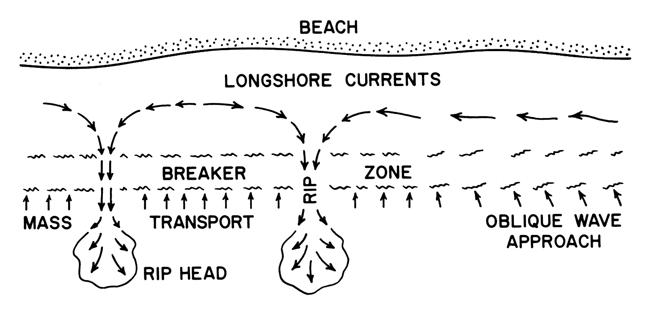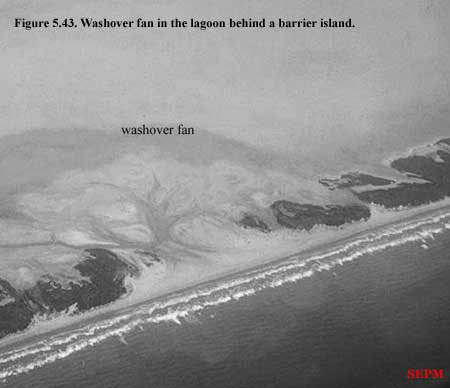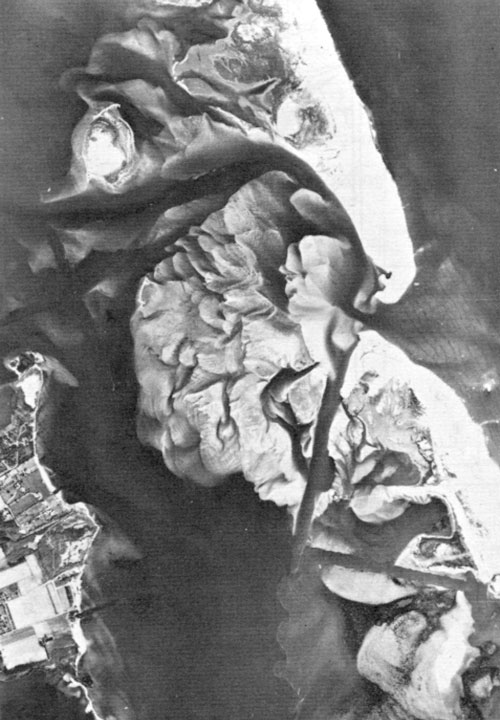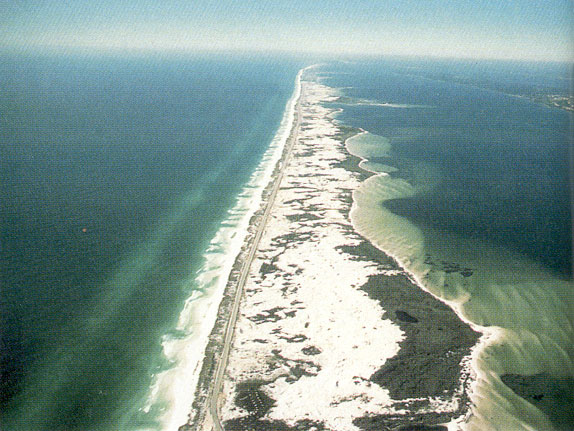Angle of and intensity of wave action
Wave action, in one form or another, dominates the development and continued existence of barrier islands. All of the sands and silts which constitute barrier islands were deposited there either by wind action, which is of relatively little import in the development of the islands except as the winds affect the development of waves, or by wave action, the defining developmental aspect of barrier island
A number of features are formed by wave action. In the region of the beach termed the shoreface, the base of the waves first begin to affect the bottom at depths of about 10 – 20 meters, depending on the size of the waves. These deeper waters have comparatively little wave affect, and the sediments are finegrained sands and silts. These deposits are often layered, or laminated, but this is sometimes obliterated by bioturbation, which is a disturbance by biological organisms through burrowing or some other penetration. In the region termed the middle shoreface, the wave action is more pronounced. This is the region in which longshore bars develop. These are structures which form when the shoreward drag of the wave base and the backwash of the breakers is balanced. These are characterized by well-sorted medium to fine grained sands and shell hash. The upper shoreface, also called the surf zone, is dramatically affected by wave-driven longshore currents but more so by the plunging effect of breaking waves.

Connection between wave approach and longshore transport (from Walker and James, 1992)
Sands and silts come from a variety of sources. Inflow from inland erosional events provide the bulk of the sediments, with some help from erosion just offshore on now submerged terrain features which in the geologically recent past were exposed to aerial erosion. The real operative agent of sand and silt development is the constant reworking of these sediments through continual movement by wave action.
Storm Events
Just after Hurricane Hugo a beachcomber called the South Carolina State Museum with a remarkable tale. He had found the legs and jaws of some "fossils" which had been washed out of the back beach of Fripp Island, South Carolina. He brought them to the State Museum where they were identified as the remains of domestic cattle which, interestingly, had been butchered! It turns out that the area had been a supply dump for the Union Army during the Civil War, and the cattle had been butchered to feed the troops that ultimately attacked Battery Wagner, a rebel artillery garrison covering the approaches to Charleston Harbor. This attack was the one immortalized in the movie "Glory."
The shoreface is very susceptible to erosion by exceptionally powerful surf which develops as a result of major storms. The structures developed as a result of normal surf, such as longshore bars, are destroyed, to be replaced by the sand load of the receding storm surge. In fact, the entire sequence of beach deposits may be replaced by storm deposits as the storm recedes.

Flood delta formed on the landward side of a barrier island which was breached by a hurricane
Particularly during hurricane-force storms, but occasionally by unusually high tides, the berm line of a beach may be breached. The waves that overtop the dune line carry sands and silts over the top of the berm and deposit them in fan-shaped lobes on the landward side of the barrier. These are termed washover deposits. These deposits may range from a few centimeters to a few meters in thickness.
Storms, with their high energy, are capable of moving huge amounts of water with the high winds that are usually associated with them. As gravity is the law, this water must move, if forced, and must recede when the force is removed. Water is one of the great eroding forces of the planet, and huge amounts of water will build or reduce sand structures very quickly, including barrier islands.

Washover deposits on the inland side of a barrier island formed by a Noreaster blizzard
 Numerous washover deposits to lea of a barrier island
Numerous washover deposits to lea of a barrier island
If the storm surge is strong enough, the foreshore of the barrier island may be so badly eroded that the dune line and the maritime forests often found rearward are damaged or destroyed. This opens up the interiors of the barrier islands to erosion, and, if the overwash is very powerful, the beach may be moved landward by shifting all of the beach and dune sands into areas once occupied by maritime forests.
A number of web sites are available to read further on hurricanes. A list of the following will prove helpful:
Hurricane Katrina
Hurricane Hugo
Hurricane Andrew
For up-to-the-minute weather see http://www.weather.com.